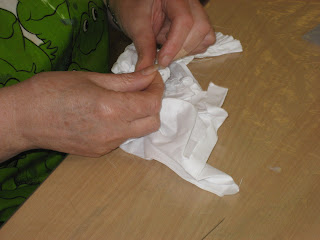

Three members of Silk-n-Threads enjoying the evening and wine are left to right, Muriel Draper, Joy Wheatley and Jean Davies.
The aim of this blog is enable the members of Silk-n-Threads to share their works with each other as well as a wider audience.


 Hello there. I am a member of Silk-n-Threads and also of the International Guild of Silk Painters. As a long distance member of Cheshire Branch I do not get to many of the meetings but I always enjoy it when I do! To make up for this, I have organised exhibitions for Silk- n-Threads at Buxton, Derbyshire where I live.
Hello there. I am a member of Silk-n-Threads and also of the International Guild of Silk Painters. As a long distance member of Cheshire Branch I do not get to many of the meetings but I always enjoy it when I do! To make up for this, I have organised exhibitions for Silk- n-Threads at Buxton, Derbyshire where I live.
 Big Bird on a Beach Hut & Big Bird on a Deck Chair
Big Bird on a Beach Hut & Big Bird on a Deck Chair  Tulip Field
Tulip Field
I ran a workshop based on a drawing of a field of tulips. Tulips are a nice easy shape for beginners and while the design is simple, it worked really well with these colours and the gold gutta. It’s my favourite silk painting and I wouldn’t part with it.

Anemones
My most recent flower painting. I received this bunch of Anemones for my Wedding Anniversary and thought the colours were absolutely stunning. Often I have to photograph flowers as they die or wilt before I get chance to paint them. But with these I had time and was able to draw the design directly from the flowers. I used black gutta and created the depth of colour with quite a few layers of silk paint. I completed the painting with a ‘sunburst effect’ background, produced by painting wet on wet.

Jungle
I love painting in this cartoon style. It’s really a design for a child’s room inspired by a painting session I had with some small children who were asked to paint their favourite animal. I used black gutta and added a stripy animal border for interest.

Cow Parsley
A very simple painting produced without a detailed drawing for once. With the branch of cow parsley in front of me and using clear gutta, I drew the main stem with three smaller stems and then just dabbed dots of gutta at random for the flower heads. When it was dry I painted over the whole design and scattered table salt across it. Then I washed out the clear gutta.

Foxglove


Maggie and Muriel with their hands in the indigo vat. The fabric had to be held under the surface for 5 minutes. We had to be careful not to disturb the surface which would have added oxygen to the vat thereby reducing the dyeing qualities of the dye.
Note the green tinge of the fabric this is the colour the fabric is when first removed from the vat. Only when it is oxygenated in the air does it turn to blue.
Out to dry, in the afternoon we tried a range of larger samples, amongst them scarves that were clamped and wrapped around poles shibori style.
A hand stitched row of leaves although some of the group thought that they would make good fish. Belinda who completed them was very pleased with the result.
Annette clamped this scarf to get this striking effect.
This is a napkin that Denise sewed in a spiral resulting in this effective end result.
Maggie used a predyed scarf that she folded into a cone before knotting it several times.
Joy tied this chiffon scarf and this delicate pattern was achieved.
A bold pattern achieved by Pauline by tieing large marbles with string.
Beryl's butterfly was achieved by sewing the shape on to cotton, she intends highlighting the features with embroidery.
 This was a piece of silk satin and again the lack of flat colour creates a unique effect.
This was a piece of silk satin and again the lack of flat colour creates a unique effect.
 This photograph was taken at the 2005 Harrogate exhibition when she was manning the stall of the Guild of Silk Painters.
This photograph was taken at the 2005 Harrogate exhibition when she was manning the stall of the Guild of Silk Painters.



